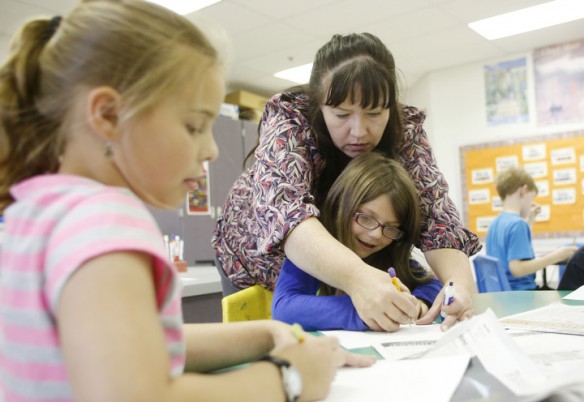
Valynn Spearman helps 3rd-grade student Kassie Evans draw eyes on her self-portrait during art class at Allen County Primary Center.
Photo by Amy Wallot, May 15, 2014
By Brenna R. Kelly
brenna.kelly@education.ky.gov
As art teacher Valynn Spearman explained the concept of balance to her 3rd-grade students at Allen County Primary School, she held up brightly colored portraits by the late pop artist James Rizzi.
“We talked about how Rizzi had a cartoon-like style, rather than having them in proportion,” said Spearman, who teaches art to kindergartners through 3rd-graders.
Then, as she reminded the students to think about balance, Spearman directed them to create self-portraits in Rizzi’s exaggerated style.
Instead of just memorizing the definition of balance, or studying the career of the famous artist, Spearman’s students were learning about art the way the new National Core Arts Standards envision – by doing.
The standards, which were presented to the Kentucky Board of Education in August, were developed over three years by a coalition of national arts organizations under the direction of Phil Shepherd, former arts consultant and current academic core branch manager at the Kentucky Department of Education.
“These new standards are process standards, rather than content standards,” said Shepherd, who served as project director for the National Coalition for Core Arts Standards. “It’s all about doing the arts.”
The new standards, which were published by the coalition in June, cover dance, media arts, music, theater and visual arts. They are organized by artistic processes including: creating, performing/presenting/producing, responding and connecting.
The emphasis on “doing the arts” is something that was important for Kentucky to have included in new arts standards, Shepherd said.
Senate Bill 1 (2009), which called on the state to increase the rigor of its arts and academic standards to prepare students for college and careers, also required the state’s schools to “develop their students’ ability to express their creative talents and interests in visual arts, music, dance and dramatic arts.”
That’s a change from the state’s current arts standards, Shepherd said. Those standards, which were subject to state assessments until 2009, were heavily content based.
“They were written so that they could be tested using pencil and paper,” Shepherd said. “They included very specific artists, the elements of the art form, a lot of facts and specific information about the arts.”

Third-grade students create self-portraits in the style of American pop artist James Rizzi.
Photo by Amy Wallot, May 15, 2014
The new arts standards will also not be subject to state tests, but will be assessed at the classroom level through performance tasks, he said. Written into the standards were model cornerstone assessments that teachers can use as is, or use asa guide to create their own assessments, Shepherd said.
“Students will have to know content in order to be able to do these tasks,” he said. “There is content involved, but we’re not focused on the content.”
The standards are broken down by discipline, process and grade level for pre-kindergarten through 8th grade. There are also three levels of high school standards: proficient, accomplished and advanced.
One example of a pre-kindergarten standard for music is to “explore and experience a variety of music.”
“So there is content in that, but it’s about doing something,” Shepherd said. “The standards allow teachers a great deal of freedom to determine how they are going to teach to the standards.”
That flexibility will allow teachers to cater their instruction to individual students, he said.
Another change in the arts standards is that media arts was included for the first time. The writers felt that the processes used to create media art such as digital art, computer animation, graphics, and websites, were the same that were often used to create an artistic product, Shepherd said. That genre also includes technology.
“A lot of what we see in media arts is generated through computer programs and software that are specifically designed to work with imagery and music,” Shepherd said. “A lot of the processes from technology had to be brought into these standards.”
Another difference is the way the standards were published, he said. The standards are on an interactive website that allows teachers to customize a list of the standards they need. Teachers can print out the information or email it.
For example, a 5th-grade music teacher can select the grade, discipline and process and the site will create the list. Or a principal could ask a teacher to share what standards are being addressed in class and the teacher could email him a customized list.
Before the standards were finalized, there were four public comment periods. The writers received more than 1 million comments and read every one, he said.
“I’m really proud of Kentucky – out of the entire country the feedback from Kentucky was the third largest,” Shepherd said.
Though new standards are not yet officially part of the Kentucky Core Academic Standards, teachers can begin implementing them this school year, Shepherd said.
“They are on the website, they are available for Kentucky teachers to use,” he said. The standards were written with the hope that states would adopt them, Shepherd said.
The Board of Education will hold a first reading of the standards in October, with a vote scheduled in December. After 30 days for public comment, a hearing by the board and review by the General Assembly, they could be implemented for the 2015-16 school year.
Spearman said she’s excited to delve into the new standards. She anticipates students will benefit from a more well-rounded, cohesive arts education.
“People who don’t have an arts education and don’t have the exposure to it, they think in a cookie-cutter way. They have trouble thinking creatively and having the problem-solving skills to help them in life,” she said. “The arts help students become a much more balanced person. I just think it’s vital for their growth and creativity.”
FOR MORE INFO …
Phil Shepherd, phil.shepherd@education.ky.gov



Leave A Comment